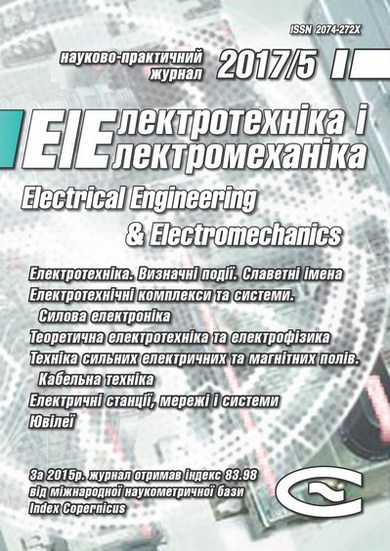CALCULATION OF MAGNETIC FIELD OF THREE-PHASE CABLE LINES WITH TWO-POINT BONDED CABLE SHIELDS COVERED BY FERROMAGNETIC CORES
DOI:
https://doi.org/10.20998/2074-272X.2017.5.06Keywords:
cable line, shield of cable, magnetic field, bonded shields, ferromagnetic coreAbstract
In this paper we obtain compact expressions for the magnetic field shielding factor of a high-voltage three-phase cable line consisting of single-core cables with two-point bonded cable shields and ferromagnetic cores installed. To obtain these expressions we develop the analytical model of the cable line. Following assumptions are made to develop the model: the current distribution in each cable shield is uniform, cylindrical ferromagnetic cores covering the cables are not magnetized to saturation and their magnetic permeability is constant, each of the ferromagnetic cores is magnetized only by the core current and the shield current of the cable that it covers, the magnetic field inside ferromagnetic cores is axisymmetric, the magnetic field is plane-parallel over the entire cable line. We consider common cases of flat and trefoil cable lines. The proposed expressions for the magnetic field shielding factor are verified experimentally. The physical model is made of three cables of the type NA2XSF(L)2Y-110 1´240/70. It is shown that the difference between numerical simulation results and experimental data lays within 15 %.References
1. Pravila ulashtuvannya electroustanovok [Electrical installation regulations]. 5th ed. Kharkiv, Мinenergovugillya of Ukraine, 2014. 793 p. (Ukr).
2. Rezinkina M.M., Grinchenko V.S. Underground busbars magnetic field mitigation with the help of electro-magnetic shields, consisted of U-shaped elements. Bulletin of NTU «KhPI», 2012, no.49, pp. 73-78. (Rus).
3. Canova A., Giaccone L. A novel technology for magnetic-field mitigation: High magnetic coupling passive loop. IEEE Transactions on Power Delivery, 2011, vol.26, no.3, pp. 1625-1633. doi: 10.1109/tpwrd.2010.2099671.
4. De Wulf M., Wouters P., Sergean P., Dupre´ L., Hoferlin E., Jacobs S., Harlet P. Electromagnetic shielding of high-voltage cables. Journal of Magnetism and Magnetic Materials, 2007, vol.316, no.2, pp. 908-911. doi: 10.1016/j.jmmm.2007.03.137.
5. Rozov V.Yu., Kvytsynskyi A.A., Dobrodeyev P.N., Grinchenko V.S., Erisov A.V. and Tkachenko O.O. Study of the magnetic field of three phase lines of single core power cables with two-end bonding of their shields. Electrical engineering & electromechanics, 2015, no.4, pp. 56-61. (Rus). doi: 10.20998/2074-272X.2015.4.11.
6. SOU-N MEV 40.1-37471933-49:2011.2. Proektuvannia kabelnykh linii napruhoiu do 330 kV. Nastanova [Design of cable lines with voltage up to 330 kV. Guidance]. Kyiv, Мinenergovugillya of Ukraine Publ., 2017, 139 p. (Ukr).
7. SOU-N ЕЕ 20.179:2008. Rozrakhunok elektrychnoho i mahnitnoho poliv linii elektroperedavannia. Metodyka [Calculation of the electric and magnetic fields of power line. Method]. Kyiv, Мinenergovugillya of Ukraine Publ., 2016, 34 p. (Ukr).
8. Rozov V.Yu., Dobrodeyev P.N., Erisov A.V., Tkachenko A.O. Increasing the efficiency of contour shielding of the magnetic field of high-voltage cable lines. Tekhnichna Elektrodynamika, 2016, no.4, pp. 5-7. (Rus).
9. Rozov V.Yu., Tkachenko O.O., Erisov A.V. and Grinchenko V.S. Analytical calculation of magnetic field of three-phase cable lines with two-point bonded shields. Tekhnichna Elektrodynamika, 2017, no.2, pp. 13-18 (Rus).
10. Demirchian K.S., Neiman L.R., Korovkin N.V., Chechurin V.L. Teoreticheskie osnovy elektrotekhniki: V 3-kh t. Uchebnik dlia vuzov. Tom 1 [Theoretical bases of electrical engineering. In 3 vols. Vol.1]. St. Petersburg, Piter Publ, 2003. 463 p. (Rus).
11. Kalantarov P.L., Tseytlin L.A. Raschet induktivnostey [Inductance calculations]. Leningrad, Energoatomizdat Publ., 1986. 488 p. (Rus).
Downloads
Published
How to Cite
Issue
Section
License
Copyright (c) 2017 V. Yu. Rozov, V. S. Grinchenko, A. O. Tkachenko

This work is licensed under a Creative Commons Attribution-NonCommercial 4.0 International License.
Authors who publish with this journal agree to the following terms:
1. Authors retain copyright and grant the journal right of first publication with the work simultaneously licensed under a Creative Commons Attribution License that allows others to share the work with an acknowledgement of the work's authorship and initial publication in this journal.
2. Authors are able to enter into separate, additional contractual arrangements for the non-exclusive distribution of the journal's published version of the work (e.g., post it to an institutional repository or publish it in a book), with an acknowledgement of its initial publication in this journal.
3. Authors are permitted and encouraged to post their work online (e.g., in institutional repositories or on their website) prior to and during the submission process, as it can lead to productive exchanges, as well as earlier and greater citation of published work.





